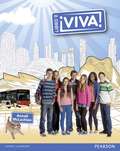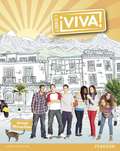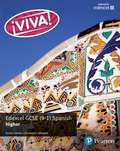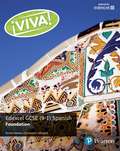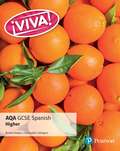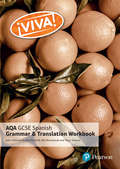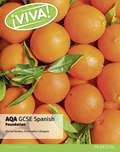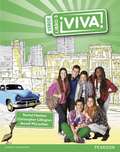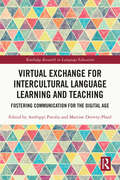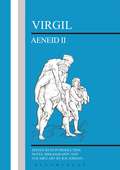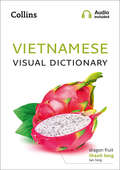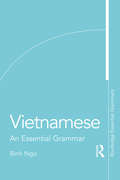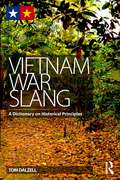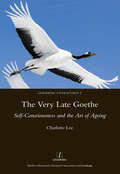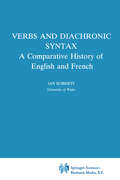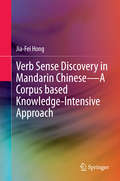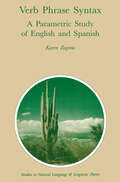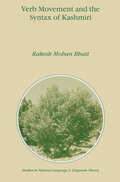- Table View
- List View
Viva! Pupil Book 2 (PDF)
by Anneli MclachlanLanguage is introduced in short, easy-to-remember phrases.
Viva! Pupil Book 1 (PDF)
by Anneli MclachlanViva! is a new fully-differentiated Key Stage 3 Spanish course packed with content pupils will enjoy learning and which opens the window to the Spanish-speaking world. With a strong focus on developing language learning skills, Viva! encourages students to manipulate language independently, helping to prepare them for KS4 and beyond.
Viva! Edexcel Gcse Spanish Higher Student Book (PDF)
by Rachel Hawkes Christopher LillingtonExpertly structured Student Book for Edexcel GCSE (9-1) Spanish (higher tier). Designed to help learners use language independently and to the best of their ability, with fresh and engaging content from the target language culture. Suitable for the new Edexcel GCSE (9-1) Spanish qualification (higher tier). A carefully designed programme of learning teaches the 'building blocks' of Spanish grammar and vocabulary. Includes popular topics, authentic material and real life-contexts; all with links to the Spanish culture. Each unit and module is structured to allow gradual progression. Exam preparation units are included for Reading, Writing, Speaking and Listening. Revision forms the final module.
Viva! Edexcel GCSE Spanish Foundation Student Book (PDF)
by Rachel Hawkes Christopher LillingtonExpertly structured Student Book for Edexcel GCSE (9-1) Spanish (foundation tier). Designed to help learners use language independently and to the best of their ability, with fresh and engaging content from the target language culture. Designed for the new Edexcel GCSE (9-1) Spanish qualification (foundation tier). A carefully designed programme of learning teaches the 'building blocks' of Spanish grammar and vocabulary. Includes popular topics, authentic material and real life-contexts; all with links to the Spanish culture. Each unit and module is structured to allow gradual progression. Exam preparation units are included for Reading, Writing, Speaking and Listening. Revision forms the final module.
Viva! AQA GCSE Spanish Higher Student Book (PDF)
by Rachel Hawkes Christopher LillingtonExpertly structured Student Book for AQA GCSE Spanish (higher tier) for first teaching from 2016. Designed to help learners use language independently and to the best of their ability, with fresh and engaging content from the target language culture. Designed for the new AQA GCSE Spanish qualification (foundation tier). A carefully designed programme of learning teaches the 'building blocks' of Spanish grammar and vocabulary. Includes popular topics, authentic material and real life-contexts; all with links to the Spanish culture. Each unit and module is structured to allow gradual progression. Exam preparation units are included for Reading, Writing, Speaking and Listening. Revision forms the final module.
Viva! Aqa Gcse Spanish Grammar And Translation Workbook (Viva! AQA GCSE Spanish)
by Tracy Traynor Ian Kendrick John Halksworth Ben KonopinskiA dedicated workbook to support and consolidate grammar learning and translation skills for AQA GCSE Spanish for first teaching from 2016. Includes: explanations of key grammar points, verb tables, and exercises to embed grammar knowledge translation exercises and strategies for translation both into Spanish and into English a bank of revision translations bringing together grammar and vocabulary learning from throughout the course clear links to the Viva! Student Books from the same series.
Viva! 1 Workbook B Pack (PDF)
by Ana Kolkowska Libby Mitchell'Viva' Spanish resources are packed with content your pupils will enjoy learning. Plus, they move at the right place - whether or not your pupils have prior knowledge - and they open the window to the Spanish-speaking world.
Viva!: AQA GCSE Spanish, Foundation student book (PDF)
by Christopher Lillington Rachel HawkesExpertly structured Student Book for AQA GCSE 2016 Spanish (foundation tier). Designed to help learners use language independently and to the best of their ability, with fresh and engaging content from the target language culture. Designed for the new AQA GCSE Spanish qualification (foundation tier). A carefully designed programme of learning teaches the 'building blocks' of Spanish grammar and vocabulary. Includes popular topics, authentic material and real life-contexts; all with links to the Spanish culture. Each unit and module is structured to allow gradual progression. Exam preparation units are included for Reading, Writing, Speaking and Listening. Revision forms the final module.
Viva!: Verde Pupil Book 3 (PDF)
by Anneli Mclachlan Rachel Hawkes Christopher LillingtonUPSILONViva is packed with content your pupils will enjoy learning, with a tried-and-tested approach to progression. 9781447947370 9781447947318 9781447960331
Virtual Exchange for Intercultural Language Learning and Teaching: Fostering Communication for the Digital Age (Routledge Research in Language Education)
by Anthippi Potolia Martine Derivry-PlardThis book illustrates new virtual intercultural practices for language learning from primary to tertiary education and highlights the transversality of these practices throughout the language curriculum. The current English as a Lingua Franca (ELF) perspective sets the framework as a possible vector of cultural exchanges in a variety of contexts, and from which the different authors coming from Europe and all over the world present their studies. The book deploys diverse educational exchanges within a wide range of technological tools and with varied approaches to the intercultural dimension in language learning. Through these virtual exchanges, different languages and educational cultures come together to create emerging communities of practice co-constructed for the limited time-space of the collaborative projects. This volume opens a dialogue with researchers from different backgrounds and theoretical and methodological perspectives as technology can no longer be apprehended without its purposeful human and semiotic meanings and, conversely, human and semiotic meanings can no longer be apprehended without Information and Communication Technology (ICT). Going beyond strict polarised views on the technology or humanistic approaches, this book presents a more nuanced, interrelated stance and will appeal to researchers, scholars, post graduate students, and teachers in applied linguistics, language learning and teaching, education, information studies, cultural studies, and intercultural communication.
Virtual Exchange for Intercultural Language Learning and Teaching: Fostering Communication for the Digital Age (Routledge Research in Language Education)
by Anthippi Potolia Martine Derivry-PlardThis book illustrates new virtual intercultural practices for language learning from primary to tertiary education and highlights the transversality of these practices throughout the language curriculum. The current English as a Lingua Franca (ELF) perspective sets the framework as a possible vector of cultural exchanges in a variety of contexts, and from which the different authors coming from Europe and all over the world present their studies. The book deploys diverse educational exchanges within a wide range of technological tools and with varied approaches to the intercultural dimension in language learning. Through these virtual exchanges, different languages and educational cultures come together to create emerging communities of practice co-constructed for the limited time-space of the collaborative projects. This volume opens a dialogue with researchers from different backgrounds and theoretical and methodological perspectives as technology can no longer be apprehended without its purposeful human and semiotic meanings and, conversely, human and semiotic meanings can no longer be apprehended without Information and Communication Technology (ICT). Going beyond strict polarised views on the technology or humanistic approaches, this book presents a more nuanced, interrelated stance and will appeal to researchers, scholars, post graduate students, and teachers in applied linguistics, language learning and teaching, education, information studies, cultural studies, and intercultural communication.
Virgil, Aeneid 11, Pallas and Camilla, 1–224, 498–521, 532–596, 648–689, 725–835: Latin Text, Study Aids with Vocabulary, and Commentary (Classics Textbooks #7)
by Ingo Gildenhard John HendersonA dead boy (Pallas) and the death of a girl (Camilla) loom over the opening and the closing part of the eleventh book of the Aeneid. Following the savage slaughter in Aeneid 10, the book opens in a mournful mood as the warring parties revisit yesterday’s killing fields to attend to their dead. One casualty in particular commands attention: Aeneas’ protégé Pallas, killed and despoiled by Turnus in the previous book. His death plunges his father Evander and his surrogate father Aeneas into heart-rending despair – and helps set up the foundational act of sacrificial brutality that caps the poem, when Aeneas seeks to avenge Pallas by slaying Turnus in wrathful fury. Turnus’ departure from the living is prefigured by that of his ally Camilla, a maiden schooled in the martial arts, who sets the mold for warrior princesses such as Xena and Wonder Woman. In the final third of Aeneid 11, she wreaks havoc not just on the battlefield but on gender stereotypes and the conventions of the epic genre, before she too succumbs to a premature death. In the portions of the book selected for discussion here, Virgil offers some of his most emotive (and disturbing) meditations on the tragic nature of human existence – but also knows how to lighten the mood with a bit of drag. This course book offers the original Latin text, vocabulary aids, study questions, and an extensive commentary. Designed to stretch and stimulate readers, Ingo Gildenhard’s volume will be of particular interest to students of Latin studying for A-Level or on undergraduate courses. It extends beyond detailed linguistic analysis to encourage critical engagement with Virgil’s poetry and the most recent scholarly thought. King's College, Cambridge, has generously contributed to this publication.
Virgil: Aeneid II
by Virgil R. H. JordanIn Book II of the "Aeneid", Aeneas relates to Dido his own account of Troy's destruction and his escape, including the episode of the Wooden Horse. It is some of the best Latin poetry ever written, and thus makes an ideal introduction to the "Aeneid". This completely new edition aims to provide students with help in translation, encourage them to consider the sound of the poetry, and appreciate the emotional impact of the story as Virgil portrays it. The text also includes a general introduction, a select bibliography, notes and a full vocabulary; appendices deal with meter and scansion.
Virgil: Aeneid Ii (Latin Texts Ser.)
by Virgil R. H. JordanIn Book II of the "Aeneid", Aeneas relates to Dido his own account of Troy's destruction and his escape, including the episode of the Wooden Horse. It is some of the best Latin poetry ever written, and thus makes an ideal introduction to the "Aeneid". This completely new edition aims to provide students with help in translation, encourage them to consider the sound of the poetry, and appreciate the emotional impact of the story as Virgil portrays it. The text also includes a general introduction, a select bibliography, notes and a full vocabulary; appendices deal with meter and scansion.
Vietnamese Visual Dictionary: A Photo Guide To Everyday Words And Phrases In Vietnamese (Collins Visual Dictionary)
by Collins DictionariesA photographic guide to the key words and phrases in Vietnamese. This attractive pocket-sized book is a perfect travel companion and provides a practical guide to Vietnam and Vietnamese language and culture.
Vietnamese: An Essential Grammar (Routledge Essential Grammars)
by Binh NgoVietnamese: An Essential Grammar is a concise and user-friendly reference guide to modern Vietnamese. It presents a fresh and accessible description of the language in short, readable sections. Features include: Clear and up-to-date examples of modern usage. Special attention to those points which often cause problems to English-speaking learners. Vietnamese / English comparisons and contrasts highlighted throughout. The final section covers pronunciation, providing an introduction to the syllable structure of Vietnamese, and highlighting common errors made by English-speaking learners. Accompanying audio tracks for this chapter are available at www.routledge.com/9781138210707. Vietnamese: An Essential Grammar is ideal for learners involved in independent study and for students in schools, colleges, universities and adult classes of all types.
Vietnamese: An Essential Grammar (Routledge Essential Grammars)
by Binh NgoVietnamese: An Essential Grammar is a concise and user-friendly reference guide to modern Vietnamese. It presents a fresh and accessible description of the language in short, readable sections. Features include: Clear and up-to-date examples of modern usage. Special attention to those points which often cause problems to English-speaking learners. Vietnamese / English comparisons and contrasts highlighted throughout. The final section covers pronunciation, providing an introduction to the syllable structure of Vietnamese, and highlighting common errors made by English-speaking learners. Accompanying audio tracks for this chapter are available at www.routledge.com/9781138210707. Vietnamese: An Essential Grammar is ideal for learners involved in independent study and for students in schools, colleges, universities and adult classes of all types.
Vietnam War Slang: A Dictionary on Historical Principles
by Tom DalzellIn 2014, the US marks the 50th anniversary of the Gulf of Tonkin Resolution, the basis for the Johnson administration’s escalation of American military involvement in Southeast Asia and war against North Vietnam. Vietnam War Slang outlines the context behind the slang used by members of the United States Armed Forces during the Vietnam War. Troops facing and inflicting death display a high degree of linguistic creativity. Vietnam was the last American war fought by an army with conscripts, and their involuntary participation in the war added a dimension to the language. War has always been an incubator for slang; it is brutal, and brutality demands a vocabulary to describe what we don’t encounter in peacetime civilian life. Furthermore, such language serves to create an intense bond between comrades in the armed forces, helping them to support the heavy burdens of war. The troops in Vietnam faced the usual demands of war, as well as several that were unique to Vietnam – a murky political basis for the war, widespread corruption in the ruling government, untraditional guerilla warfare, an unpredictable civilian population in Vietnam, and a growing lack of popular support for the war back in the US. For all these reasons, the language of those who fought in Vietnam was a vivid reflection of life in wartime. Vietnam War Slang lays out the definitive record of the lexicon of Americans who fought in the Vietnam War. Assuming no prior knowledge, it presents around 2000 headwords, with each entry divided into sections giving parts of speech, definitions, glosses, the countries of origin, dates of earliest known citations, and citations. It will be an essential resource for Vietnam veterans and their families, students and readers of history, and anyone interested in the principles underpinning the development of slang.
Vietnam War Slang: A Dictionary on Historical Principles
by Tom DalzellIn 2014, the US marks the 50th anniversary of the Gulf of Tonkin Resolution, the basis for the Johnson administration’s escalation of American military involvement in Southeast Asia and war against North Vietnam. Vietnam War Slang outlines the context behind the slang used by members of the United States Armed Forces during the Vietnam War. Troops facing and inflicting death display a high degree of linguistic creativity. Vietnam was the last American war fought by an army with conscripts, and their involuntary participation in the war added a dimension to the language. War has always been an incubator for slang; it is brutal, and brutality demands a vocabulary to describe what we don’t encounter in peacetime civilian life. Furthermore, such language serves to create an intense bond between comrades in the armed forces, helping them to support the heavy burdens of war. The troops in Vietnam faced the usual demands of war, as well as several that were unique to Vietnam – a murky political basis for the war, widespread corruption in the ruling government, untraditional guerilla warfare, an unpredictable civilian population in Vietnam, and a growing lack of popular support for the war back in the US. For all these reasons, the language of those who fought in Vietnam was a vivid reflection of life in wartime. Vietnam War Slang lays out the definitive record of the lexicon of Americans who fought in the Vietnam War. Assuming no prior knowledge, it presents around 2000 headwords, with each entry divided into sections giving parts of speech, definitions, glosses, the countries of origin, dates of earliest known citations, and citations. It will be an essential resource for Vietnam veterans and their families, students and readers of history, and anyone interested in the principles underpinning the development of slang.
The Very Late Goethe: Self-Consciousness and the Art of Ageing
by Charlotte LeeGoethe's career was an unusually long and productive one: he became a literary celebrity in the 1770s and remained so until his death in 1832. The distinguishing feature of his last works is their self-consciousness, their preoccupation both with the business of writing and with personal development. In the first cross-genre study of this period of Goethe's work, Charlotte Lee traces the theme in his last major poems and autobiographical writings, before turning to the two 'giants', 'Wilhelm Meisters Wanderjahre' and 'Faust II'. All these works share a tendency to allude subtly to earlier moments from Goethe's own literary output, but to fashion them into writing which is quite new - even though (or perhaps because) he himself is old. This book seeks to understand the unique perspective of one nearing the end of a long life.
The Very Late Goethe: Self-Consciousness and the Art of Ageing
by Charlotte LeeGoethe's career was an unusually long and productive one: he became a literary celebrity in the 1770s and remained so until his death in 1832. The distinguishing feature of his last works is their self-consciousness, their preoccupation both with the business of writing and with personal development. In the first cross-genre study of this period of Goethe's work, Charlotte Lee traces the theme in his last major poems and autobiographical writings, before turning to the two 'giants', 'Wilhelm Meisters Wanderjahre' and 'Faust II'. All these works share a tendency to allude subtly to earlier moments from Goethe's own literary output, but to fashion them into writing which is quite new - even though (or perhaps because) he himself is old. This book seeks to understand the unique perspective of one nearing the end of a long life.
Verbs and Diachronic Syntax: A Comparative History of English and French (Studies in Natural Language and Linguistic Theory #28)
by I.G. RobertsThis book combines several strands of my work, both individually and in collaboration with various people, over the last couple of years. To a very large extent, I have been inspired by the many talks, classes, appointments and other interactions that took place in the exciting intellectual environ ment that grew up among the linguists working in Geneva in the period 1989-90. It is impossible to mention by name everyone who influenced the devel opment of this material, but I'd particularly like to thank the students in my class 'linguistique diachronique' during that period, who had to suffer through preliminary versions of much of this book, and often seemed to understand what I was getting at better than I did. Luigi Rizzi did more than anyone else to create the unique atmosphere here in the last couple of years, and so he deserves our gratitude for that; he was also my collaborator on the synchronic work on French inversion that inspired much of this book; he also read the whole manuscript in draft form and gave detailed comments; he is also, as anyone working in current comparative syntax knows, a wellspring of knowledge, ideas and inspiration. Maria-Teresa Guasti also read the entire manuscript and gave me invaluable comments. Sten Vikner was a great help, for much more than just Danish data. Special thanks also to Adriana Belletti, Anna Cardinaletti, Liliane Haegeman and Cecilia Poletto.
Verb Sense Discovery in Mandarin Chinese—A Corpus based Knowledge-Intensive Approach
by Jia-Fei HongThis book applies linguistic analysis to the poetry of Emeritus Professor Edwin Thumboo, a Singaporean poet and leading figure in Commonwealth literature. The work explores how the poet combines grammar and metaphor to create meaning, making the reader aware of the linguistic resources developed by Thumboo as the basis for his unique technique.The author approaches the poems from a functional linguistic perspective, investigating the multiple layers of meaning and metaphor that go into producing these highly textured, grammatically intricate verbal works of art. The approach is based on the Systemic Functional Theory, which aids the study of how the poet uses language (grammar) to craft his text in a playful way that reflects a love of the language. The multilingual and multicultural experiences of the poet are considered to have contributed to his uniquely creative use of language.This work demonstrates how the Systemic Functional Theory, with its emphasis on exploring the semogenic (meaning-making) power of language, provides the perspective we need to better understand poets’ works as intentional acts of meaning.Readers will discover how the works of Edwin Thumboo illustrate well a point made by Barthes, who noted that “Bits of code, formulae, rhythmic models, fragments of social languages, etc. pass into the text and are redistributed within it, for there is always language before and around the text.”With a focus on meaning, this functional analysis of poetry offers an insightful look at the linguistic basis of Edwin Thumboo’s poetic technique. The work will appeal to scholars with an interest in linguistic analysis and poetry from the Commonwealth and new literature, and it can also be used to support courses on literary stylistics or text linguistics.
Verb Phrase Syntax: A Parametric Study of English and Spanish (Studies in Natural Language and Linguistic Theory #13)
by Karen ZagonaThis study is concerned with the structure of verb phrases in English and Spanish, and with syntactic processes involving VP and Vo. A primary focus of attention is auxiliary verbs. It is argued that the structure dominating these verbs is essentially the same in English and Spanish, as is the structure dominating auxiliaries and 'main' verbs in each language. It must be concluded that the occurrence of distinct syntactic processes affecting auxiliaries and other VP constituents in the two languages does not follow from parametrization of phrase structure. It is argued that similarities between the two languages with respect to the composition of so-called "V*" constructions derive from the fact that VP is licensed under both clauses of the Principle of Full Interpretation, i. e. , predication and sub categorization. Distinct syntactic processes in English and Spanish are argued to follow from the fact that there are inflectional features related to each of these licensing conditions (including specification for [ ± PAST) and nominal person/number features) which affect government relations in distinct ways, resulting in parametrization of S-structure representa tions. xi ACKNOWLEDGMENTS I wish to express my appreCiatIOn to the Department of Romance Languages at the University of Washington for support for preparation of the final manuscript, and to the Department of Spanish, Italian and Portuguese at the University of Virginia for a leave during which much of this research was accomplished.
Verb Movement and the Syntax of Kashmiri (Studies in Natural Language and Linguistic Theory #46)
by R.M. Bhatt3. 1 Kashmiri is not "non-Configurational" 45 3. 1 . 1 Agreement 51 3 . 1. 2 Binding Theory 52 3. 1. 3 Distribution of PRO 56 3 . 1. 4 Additional Evidence 57 3. 1. 4. 1 Weak Crossover (WCO) 57 3. 1. 4. 2 Constituent Fronting 60 3. 1. 4. 3 Superiority-Like Effects 62 3. 2 Word Order Constraints: Kashmiri Phrase Structure 64 3. 2. 1 N-complements 65 3. 2. 2 Postpositions 67 3. 2. 3 Adjectives 67 3. 2. 4 The Structure ofVP 68 3. 3. The Functional Projections 71 3. 4 Complement ki clauses 74 3. 5 Summary 79 4 Verb-Second (V2) Phenomena 80 4. 0 Introduction 80 4. 1 Kashmiri Vo rfe ld 84 4. 1. 1 V2 Clauses 85 4. 1. 1. 1 Main Clauses 85 4. 1. 1. 2 ki-Clauses 98 4. 1. 2 V3 Clauses 102 4. 1. 2. 1 Declarative Clauses 102 4. 1. 2. 2 Interrogative Clauses 107 4. 2 Some Exceptional Orders 116 vm 4. 2. 1 VI Order 116 4. 2. 1. 1 Declaratives 116 4. 2. 1. 2 Yes/No Questions 120 V-Final Order 4. 2. 2 121 4. 2. 2. 1 Relative Clauses and Adverbial Clauses 121 4. 2. 2. 2 Nonfinite Clauses 126 4. 3 Summary 129 5 Motivating Verb Movement 131 5. 0 Introduction 131 5. 1 The "Standard" Account 131 5. 2 Yiddish and Icelandic 136 5. 2. 1 Diesing (1990) 138 5. 2. 2 Weerman (1989) 141 5. 2. 3 Vikner (1991) 146 5.
